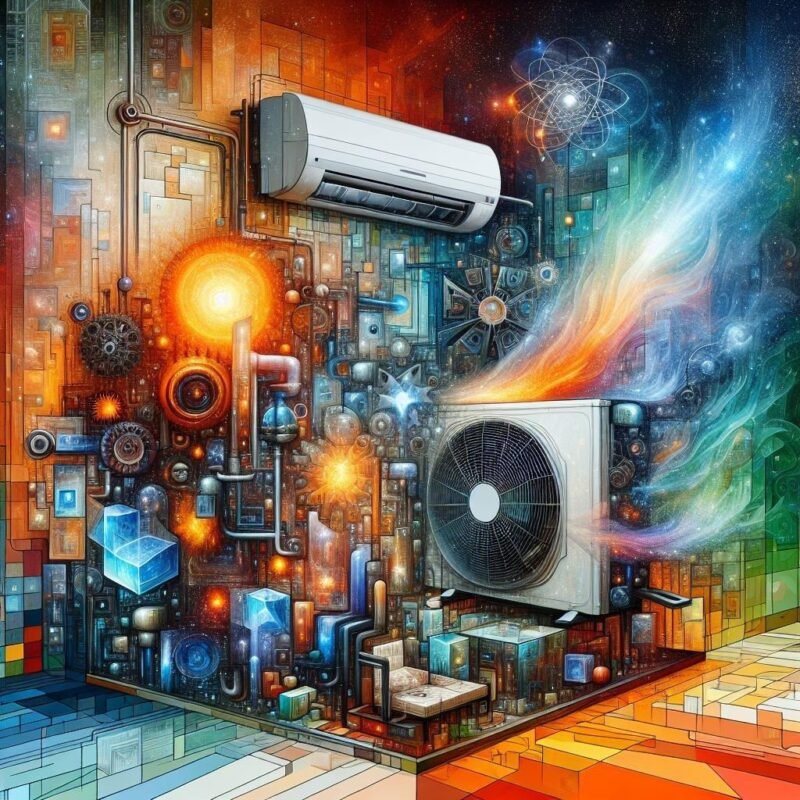The Differences Between Ductless and Mini Split AC Systems

Picture this: a scorching summer day, and you’re faced with choosing the perfect cooling solution for yoru home. While many homeowners toss around terms like “ductless” and “mini-split” as if they’re interchangeable, there’s more to these cooling companions than meets the eye. Like fraternal twins, these systems share some DNA but have their own unique personalities. Today, we’re diving into the cool world of air conditioning to unravel the subtle yet significant differences between ductless and mini-split systems, helping you navigate the refreshing path to home comfort.
Unveiling the Cool Battle: Ductless vs Mini Split Air Conditioning Systems
Ever wondered about those sleek, modern cooling solutions that have taken the HVAC world by storm? Let’s clear up a common confusion that’s been puzzling homeowners and contractors alike.here’s the plot twist: ductless and mini split systems are actually the same thing! That’s right – these terms are used interchangeably in the industry, referring to the same innovative cooling technology that eliminates the need for traditional ductwork. These systems consist of an outdoor unit connected to one or more indoor air handlers, bringing personalized comfort to different zones of your home.
What makes this cooling solution truly remarkable is its versatility and efficiency. These systems allow you to create independent temperature zones, much like having a TV remote for each room. The indoor units can be mounted high on walls, suspended from ceilings, or even tucked away in a recessed space, offering flexibility that traditional AC systems can’t match.Plus, with advanced features like inverter technology and smart controls, they’re leading the charge in energy-efficient home cooling solutions.
| Common Name | Industry Term | Key Feature |
|---|---|---|
| Ductless AC | Mini split | No ducts Required |
| Split System | Ductless Split | Zoned Cooling |
breaking Down the Technical DNA: Components and Installation Requirements
Both ductless and mini split systems share essential components that form their operational backbone. At their core lies the dynamic duo: an outdoor condenser unit and at least one indoor air handling unit.The outdoor unit houses the compressor, which acts as the system’s powerhouse, while the indoor unit, mounted high on the wall or ceiling, quietly distributes conditioned air. These units are connected through a small bundle of connections, including refrigerant lines, electrical wiring, and a condensate drain line, all neatly concealed within a protective conduit.
Installation requirements vary between these cooling solutions, though both demand professional expertise. The mounting process typically involves:
- A 3-inch hole drilled through an exterior wall for the line set
- A level mounting surface for both indoor and outdoor units
- Access to a 220V electrical circuit
- Proper clearance around outdoor units (minimum 12 inches)
- Strategic placement to maximize airflow distribution
| Component | Ductless System | Mini Split System |
|---|---|---|
| Line set Length | Up to 50 ft | Up to 100 ft |
| Indoor Units | single zone | Multiple zones |
Comfort Zones and Energy Bills: How Each System Impacts Your Home and wallet
Picture yourself basking in personalized climate control, where each room becomes your perfect temperature haven. Mini-split systems excel at creating these individualized comfort zones, allowing you to cool specific areas without wasting energy on unused spaces. Meanwhile, traditional ductless units operate on a broader scale, cooling entire sections of your home together. The ability to fine-tune temperatures in different rooms isn’t just about comfort—it’s about smart energy management that reflects directly on your monthly bills.
When it comes to the financial impact,both systems tell different stories. Here’s what savvy homeowners need to know:
- Mini-splits typically reduce energy costs by 30-40% through zone-specific cooling
- Ductless systems eliminate the 20-30% energy loss associated with ducted setups
- Both options qualify for various energy-efficiency rebates and incentives
| System type | Monthly Savings | Installation Cost |
|---|---|---|
| Mini-Split | $30-50 | Higher |
| Ductless | $25-40 | Lower |
Smart Home Integration and Modern Features: Choosing Your Perfect Climate Control Match
Modern technology has transformed the way we control our indoor climate, with both ductless and mini-split systems offering cutting-edge connectivity features. Through smartphone apps and voice assistants like Alexa or Google Home, you can adjust temperatures, set schedules, and monitor energy usage from anywhere.These smart capabilities mean you’ll never again walk into an uncomfortably warm house or waste energy cooling an empty space.
When selecting your ideal system, consider these advanced features that enhance comfort and convenience:
- WiFi-enabled controls with real-time temperature monitoring
- Zone-specific scheduling and automation
- Energy usage reports and optimization suggestions
- Maintenance alerts and filter change reminders
- Integration with existing smart home ecosystems
| Feature | Ductless | Mini Split |
|---|---|---|
| Smart Home Compatible | ✓ | ✓ |
| Zone Control | Basic | Advanced |
| Mobile App Support | limited | Full |
Q&A
Q&A: The Differences Between ductless and Mini Split AC Systems
Q: what’s the difference between ductless and mini split AC systems? Aren’t they the same?
A: Great question! While they sound similar, they actually refer to different concepts. A mini split AC system is a specific type of ductless system. Essentially, all mini splits are ductless, but not all ductless systems are mini splits. Ductless systems include a variety of configurations,while mini splits have a specific design that includes both indoor and outdoor units with refrigerant lines connecting them.
Q: What are the main components of a mini split AC system?
A: Picture a mini split system as a two-part team! It typically consists of an outdoor compressor unit and one or more indoor air handling units. These work together to cool or heat your space efficiently, without the need for ductwork.It’s like having your own personal cooling buddy—ready to help, without bulky ducts getting in the way!
Q: Are there energy efficiency benefits to going ductless?
A: Absolutely! Ductless systems, including mini splits, tend to have higher energy efficiency ratings than traditional HVAC systems with ducts.Why? Because they eliminate energy losses that often occur in ductwork, which can lose up to 30% of cooled air. So, if you want to keep both your space and energy bills cool, ductless might just be the way to go!
Q: Can I use a mini split AC system in every room?
A: You can definitely use a mini split in any room you choose! That’s one of the beauties of these systems. You can install an indoor unit in multiple rooms—like the living room, bedroom, or even a cozy home office. This allows for tailored temperature control in each space, so everyone stays comfy. Just make sure your chosen system has enough capacity to handle the total area!
Q: What about installation? Is it complicated?
A: Installing a mini split system is generally easier than traditional ducted systems. It requires only a small hole in the wall to connect the indoor and outdoor units, making it a less invasive process. If your AC technician knows their stuff, you could be up and running in as little as a day. Imagine that—cool comfort in no time!
Q: Do ductless systems make a lot of noise?
A: The good news is that both ductless and mini split systems are designed to operate quietly. Most indoor units are whisper-quiet, allowing you to enjoy your space without the sound of a roaring AC unit. Just think of them as the ninjas of the cooling world—cooling without making a racket!
Q: Are there any downsides to choosing a mini split AC system?
A: Like any system, mini splits come with a few considerations. they can have a higher upfront cost compared to traditional AC systems, and some folks find the indoor units a bit bulky on the wall. However, many agree that the energy efficiency and flexibility often make it worth the investment.
Q: Any tips for deciding between ductless and mini-split systems?
A: When in doubt, consider your space! If you’re looking for localized cooling without the hassle of ducts, rubber-stamp that mini split system. But if you want multiple cooling options and a bit of variety in your ductless solutions, explore all your ductless options! And don’t hesitate to reach out to an HVAC professional—they can definitely help you navigate the ins and outs of your distinct cooling needs.
There you have it! Now you’re all set to tackle the world of ductless and mini split AC systems. Stay cool, folks!
Future Outlook
As we draw the curtains on our exploration of ductless and mini-split AC systems, we hope you feel a little cooler and a lot more informed! Both options bring their unique charm to the table, transforming sweltering spaces into cozy havens with a flick of a switch.whether you’re captivated by the sleek design of a mini-split or the efficient versatility of a ductless system, the ultimate choice depends on your individual needs, preferences, and space.
Remember, investing in the right air conditioning system is not just about cooling down your home, but also about enhancing your comfort and well-being. So, take a deep breath, envision your perfect climate, and make an informed decision that suits your lifestyle.
thanks for joining us on this breezy journey! May your days be cool, your nights be restful, and your home always feel like a refreshing oasis. Happy chilling!






















